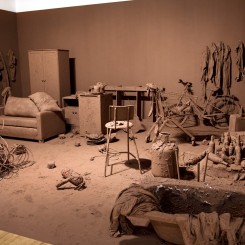“Art of Change: New Directions from China”
Hayward Gallery (Southbank Centre, Belvedere Road, London, SE1 8XX, UK). Sept 7 – Dec 9, 2012.
A title is an ambivalent thing — just as tender to interpretation as what it purports to name. Noticeable is the tendency among contemporary Chinese artists, as others, either to leave works and exhibitions “untitled” or to label them merely by their creation date, thus evading the intrusion of meaning. Needless to say, most of them still permit a wordy exhibition text which may confuse, inform or excite (or a combination of the three).
“Art of Change: New Directions from China” is a case in point; context cannot be ignored. Whilst its intention is clear, for one positioned between London and Beijing it’s difficult to avoid the involuntary substitution of “New Directions from China” by a phantom alternative, something like “Art of Changing Attitudes”.
Of course, this is not the only recent high-profile Chinese exhibition at an international institution; this year alone has seen “Go Figure! Contemporary Chinese Portraiture” at the Sherman Contemporary Art Foundation in Sydney, “Transformation: A View on Chinese Contemporary Art” at Istanbul Modern Museum and “Openness and Integration — Contemporary Chinese Art Exhibition” at the Museum of Fine Arts in Budapest. But the fact remains that each successive show feels atypical — even as momentum mounts; “taboo” is not the right word, nor is “problematic”, but perhaps “anomalous” is. These exhibitions don’t converge on a feeling of increasing integration, but are instead successive offerings widowed from wider progression. Their titles reiterate the mood emphasising change, or “transformation,” or instructing one to “work it out for yourself.” This is telling; why this sensation? And why always a sense of the sporadic?
In contemporary art, so much is merely temporary. Chinese contemporary art is in many ways at the vacillating centre of international changes occurring now. Whilst it is change within China that is always emphasized — “transformation” and “rapid urban development” being the buzz words — this is by now an unbalanced focus when it is clear that unprecedented change is happening across the geopolitical landscape. As the prime example of a region previously excluded by a Western-centric artistic canon — not to mention the threat to old orders posed by its economic might — China arises as indicative of these changes. Whether it likes it or not, the “art world” as it is called — linked inextricably to politics and commerce — cannot deny the paradigm shifts that are happening, and that necessarily entail it, too. Ironic now is the etymological link between what once was called the Orient (“East” in maps of the Middle Ages was often situated at the top, hence the link with the verb “to orientate”) — and the disorientation prevalent now and inherent in China’s heightening presence on the global stage.
As a symptom of this state of affairs, Chinese art remains largely radical and discomforting for the wider art world audience, a condition bolstered by its close association with the market (now undergoing something of an awkward adolescence) and lack of a critical framework. In the work of emerging artists from China there is much that speaks to the touchstone of artistic innovation, but attitudes keep it at bay. Asked recently to comment on Chinese art, most of the editorial team of one of Britain’s main art mags declined to respond. “I’d have to say I don’t really think about Chinese contemporary art,” said one. In reality, focussing adjectives about change on China alone is simply another form of centrism, where it is only Western commentators that deliver these descriptions, at the same time assuming themselves to be separate from this state of flux. This is a fiction.
In the context of this exhibition at the Hayward Gallery, “art of change” refers to the evolution occurring during artists’ careers, and to works of performance art that change over time; they are not finished aesthetic objects, but rather processes that continue to unfold. A parallel might have been drawn here between changing works and a changing environment, but inside the Hayward Gallery’s windowless container (as non-porous as London’s other white cubes), its walls lined with supporting documentation and where for the majority of people China, let alone its art, is wholly remote, it wasn’t. For some, such a concentrated encounter with challenging works would be positive; others will say the work “did not speak to them” (as did the owners of one of the city’s major contemporary art galleries, an echelon by no means exempt from a decided unfamiliarity with recent Chinese art). Noticeable was the agreement in both professional exhibition reviews in the local media and art blogs on which were the most striking works: Yingmei Duan’s cute/dark performance “Happy Yingmei” (2011-2012, performed live in the gallery), the live silk worm works by Liang Shaoji (“Nature Series,” dates variable) and Xu Zhen’s following piece “March 6th” (2012). The more complex works (one might say, those that were less easily “Chinese” or obviously “creepy”), for example an extract from the masterful “Making Do with Fakes” (2011) by Wang Jianwei and the infamous meat-kneading sequence by Gu Dexin — “1997-6-16-1998-6-13”, (1997-8) — were skirted by critical and colloquial commentators alike.
In general and regardless of a focus — predictable, with hindsight — on the more accessible works, the responses to “Art of Change” has been positive. For all on which this review has remarked, and less about the exhibition itself than the climate in which it arises, to seek straightforward change is unrealistic. Instead, and as part of the wider ferment, these exhibitions will continue; attitudes will swim around them, shifting in tandem with the wider image of instability and — one hopes — art world attrition.
